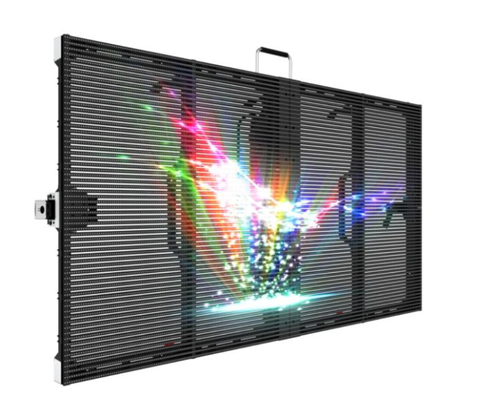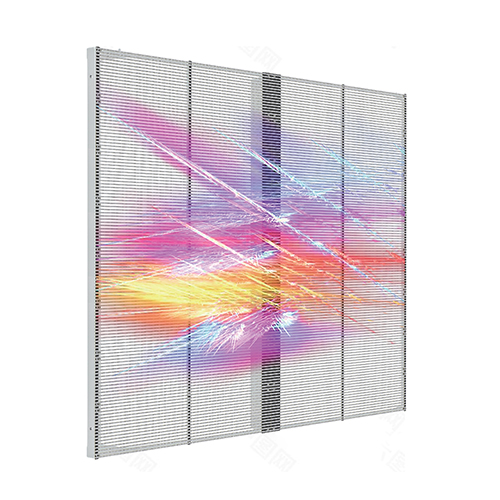NEWS
New Products
Complete Guide to Transparent LED Displays
2024-09-26ELIKEVISUAL | 2024-09-26
Transparent LED displays, commonly known as see-through LED screens, along with emerging technologies such as Mini LED and Micro LED displays, represent a significant leap in the display industry. However, many people are unfamiliar with how these displays achieve their transparency and how they function. This article will provide a comprehensive overview of transparent LED displays, helping you better understand this innovative technology in the world of LED displays.

What is a Transparent LED Display?
A transparent LED display is a type of display technology that utilizes LEDs (Light Emitting Diodes) to project images onto a transparent material, allowing viewers to see both the display content and what lies behind it simultaneously. This see-through effect makes it an excellent solution for dynamic presentations in spaces such as retail stores and showrooms.
How Does a Transparent LED Display Work?
Transparent LED displays are created by combining LED backlighting with transparent LCD glass. This unique configuration allows light emitted by the LEDs to pass through the glass, creating bright, sharp images that seem to float in mid-air.
The LEDs are arranged in a matrix grid, controlled by a system that sends signals to each individual diode, which in turn creates different images or videos on the screen. These screens contain millions of tiny LEDs, embedded between two layers of film: the top layer is transparent, allowing light to pass through, while the bottom layer reflects light back toward the viewer. By adjusting the brightness and colors emitted by each LED, the display forms vibrant, dynamic visuals.
In addition, transparent LED displays offer wide viewing angles, ensuring that the image remains crisp and undistorted from any perspective. The clever arrangement of turning off the LEDs behind the displayed content while keeping the ones in front illuminated creates the transparent effect.

Manufacturing Transparent LED Displays
Transparent LED displays rely on a careful combination of materials and advanced technology. A key element is the dual-layered glass construction, coated with anti-glare and anti-reflective treatments. These coatings ensure that the display remains clearly visible even under direct sunlight. A thin transparent LCD panel, containing thousands of individually lit pixels, is placed between the glass layers.
The LED units are installed behind the display, with a light diffuser above them to evenly distribute light across the screen. A polarizer layer helps regulate brightness and color output, creating a smooth, high-quality visual experience. The result is a seamless, edge-free display that captivates viewers.
Key Advantages of Transparent LED Displays
Transparent LED displays offer a range of benefits over traditional LED displays, making them an attractive option for many applications. Here are some of their major advantages:
- 1. Simple Installation and Maintenance
Transparent LED displays consist of modular units that can be installed separately. This makes both installation and maintenance easy, even for users with limited technical expertise.
- 2. User-Friendly Operation
These displays can be easily connected to a computer system, allowing users to update content in real-time. Some systems even allow remote control via mobile devices, adding flexibility to their operation.
- 3. High Brightness for Daytime Use
Transparent LED displays are designed to operate with high brightness levels, ensuring they remain eye-catching both day and night. Additionally, they feature adjustable brightness settings to suit various environmental conditions.
- 4. High Transparency Rates
With transparency rates reaching up to 90%, transparent LED displays deliver impressive visual effects. The higher the transparency rate, the more striking the display's impact, making it a great tool for commercial advertising.

- 5. Energy Efficient
These displays are efficient in heat dissipation and do not require air conditioning for cooling. Their low energy consumption makes them ideal for businesses looking to reduce operational costs while maximizing performance. Transparent LED displays can also be maintained from the rear, which adds to their convenience for long-term use.
- 6. Compact and Lightweight Design
Transparent LED displays are lightweight and compact, making them suitable for installation in a variety of spaces, from shopping malls to performance stages. Their space-saving design allows for greater flexibility in placement.
Common Applications of Transparent LED Displays
Transparent LED displays are becoming increasingly common in a variety of locations due to their unique advantages. Here are some of the most popular places and uses for these displays:
- 1. Shopping Malls
Transparent LED displays are widely used in shopping malls for promotional and informational purposes. Their low energy consumption makes them ideal for continuous operation, enhancing both branding and customer engagement.
- 2. Outdoor Billboards
Made from durable, flexible materials such as Polyethylene Terephthalate (PET) or Polycarbonate (PC), transparent LED displays are well-suited for outdoor billboard installations. These eco-friendly materials provide resistance against external damage while offering excellent visual performance.
- 3. Transportation Hubs
High-traffic areas like airports and train stations are prime locations for transparent LED displays. These sites offer significant advertising opportunities, and transparent displays help brands make a memorable impact on travelers.
- 4. Showrooms
Showrooms for products and services benefit from transparent LED displays due to their ability to deliver an immersive visual experience. The clarity and vibrant color rendering of these screens enhance product presentations and demonstrations.

- 5. Large Events and Concerts
Transparent LED displays are an integral part of large-scale events such as the Olympics, World Expos, and concerts. Their ability to seamlessly blend into performances and presentations, while providing high-quality visuals, makes them a valuable tool for enhancing the overall event atmosphere.
- 6. Glass Curtain Walls
Transparent LED displays are also frequently used as architectural features in glass curtain walls. They provide a sleek, modern aesthetic to buildings, delivering dynamic visuals while maintaining a clear view of the interior.
Conclusion
As the demand for innovative advertising and cutting-edge display technology grows, transparent LED displays are poised to become increasingly popular across various industries. Their unique ability to combine transparency with high-quality visuals ensures they will continue to be a key player in the future of digital displays.
Contact us at:
T: +86 755 27788284
Email: [email protected]
Tiktok: https://www.tiktok.com/@sharlkngv7e
https://www.tiktok.com/@elike53






